The single-leg deadlift is the dark horse of deadlift variations. Can you pull ultra-heavy weights with it, like you would during a rack pull? Not exactly. Is it easy to learn and perform, like the trap bar deadlift? No way. Does the single-leg deadlift have some unique advantages to it that you simply can’t get by standing on your own two feet? Actually, yes.
Single-leg training is all the rage in the weight room — you’ve probably done a one-legged squat on a recent leg day yourself. Unilateral pulls don’t get as much time to shine, but they’re just as potent for building strength, improving your coordination, and adding muscle to your backside.

Here’s how to do a pitch-perfect single-leg deadlift.
- How to Do the Single-Leg Deadlift
- Single-Leg Deadlift Sets and Reps
- Common Single-Leg Deadlift Mistakes
- Single-Leg Deadlift Variations
- Single-Leg Deadlift Alternatives
- Muscles Worked by the Single-Leg Deadlift
- Benefits of the Single-Leg Deadlift
- Who Should Do the Single-Leg Deadlift
- Frequently Asked Questions
How to Do the Single-Leg Deadlift
You can perform a single-leg deadlift with just about any type of free weight. Working with the barbell most closely resembles the deadlift itself, so that’s what this guide will instruct you on. You’ll need a barbell, full-sized plates, and sufficient open space to work.
Step 1 — Address the Bar
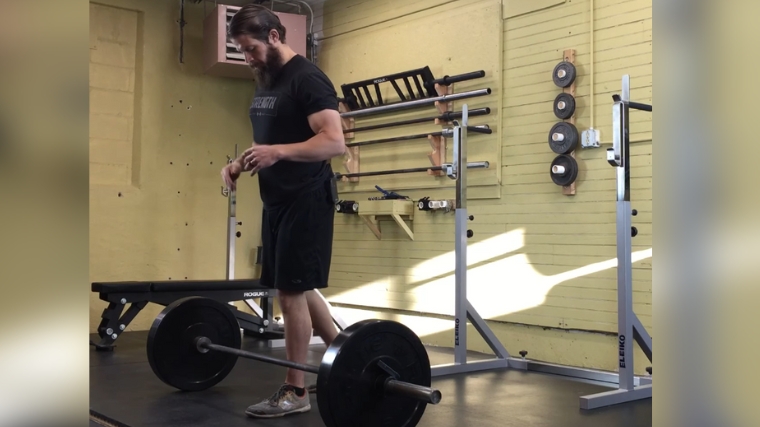
Approach a loaded barbell as you would for a regular deadlift, save for one difference; take a slight offset stance, with your working leg directly in front of the middle of the bar. You may turn your toes outward slightly if it’s more comfortable for you.
Coach’s Tip: You must stand with your feet offset from the center of the bar to maintain alignment between the weight of the bar and your own center of mass while you lift on one leg.
Step 2 — Set Yourself Up
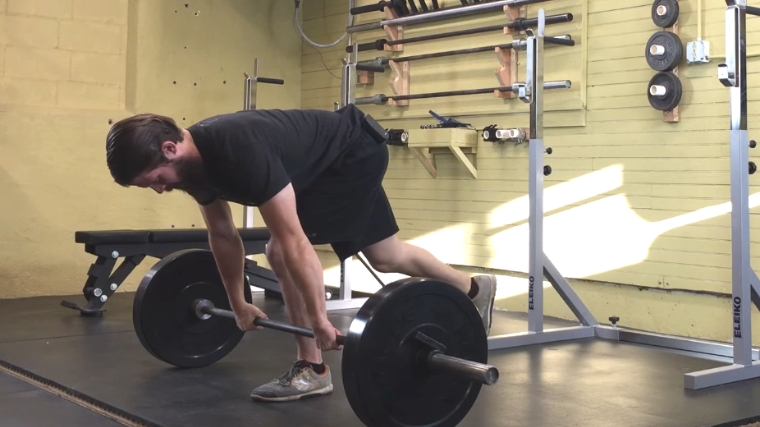
Take one step backward with your non-dominant leg and place it behind you, up on your toes, like a kickstand for a bicycle. Then, hinge at the hips and reach down to grab the bar. Grab the barbell with a shoulder-width, double-overhand grip. Your back should be flat and your shins should be mostly vertical.
Coach’s Tip: Try to fix your gaze on a specific point several feet away from you around knee or hip height to help with your balance as you move.
Step 3 — Drive Upward
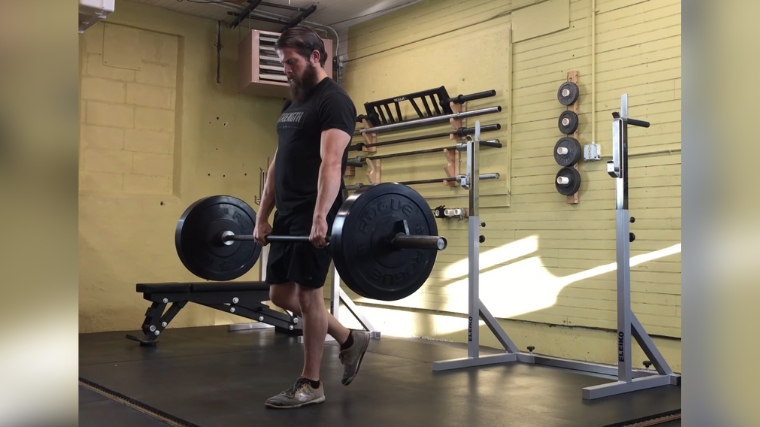
Just before you initiate the deadlift, lift your back leg off the ground and point it behind your body. Initiate the movement by pushing into the floor with your planted leg. Once the barbell has passed knee-level, push your hips forward and rise to a standing position.
Bend the knee of the non-working leg as you stand and allow it to come forward as well. You can gently touch the floor with your toes at the top to balance yourself if needed.
Coach’s Tip: Think about maintaining three points of solid contact between your foot and the ground; your big toe, pinky toe, and heel.
Step 4 — Back to the Floor
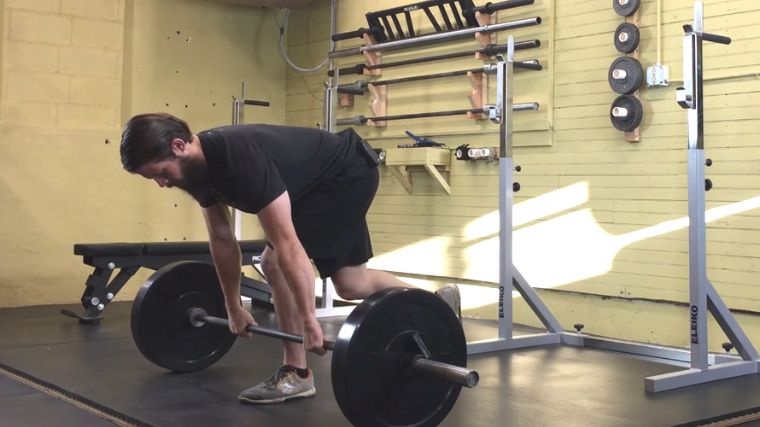
Reverse the pushing motion to return the barbell to the floor. As you tip over, let your non-working leg extend out behind your body.
Coach’s Tip: Try to maintain a neutral neck position throughout the entire range of motion.
Single-Leg Deadlift Sets and Reps
You can use the single-leg deadlift as a strength-training accessory, to build some muscle across your backside, or even as a tool for shoring up your balance and coordination. No matter your “why,” you need to know how to program the exercise to work for you. Try out some of these set-rep schemes:
- For Strength: 2 or 3 sets of 6 reps with a moderately-heavy weight.
- To Build Muscle: 3 to 4 sets of 8 to 12 reps with a moderate weight and controlled tempo.
- To Improve Balance: 2 to 3 sets of 12 or more reps with a light weight, focused on cadence.
Common Single-Leg Deadlift Mistakes
Any exercise in which you work with only one arm or leg is prone to error. After all, you’re simply not as stable or secure during a single-leg deadlift as you would be if you planted both feet firmly on the ground.
Before you pull the bar off the ground, be aware of these common errors so you can avoid them and get the most out of the exercise.
Rounding Your Back
The single-leg deadlift, like any other style of deadlift, necessitates a stable and secure spine. Pulling with your back rounded over not only compromises sound technique, but likely interferes with your balance as well. During your setup, ensure that your spine — particularly your lumbar area — is mostly flat.
Jerking the Weight
An athlete with poor balance or locomotive control may compensate for these deficiencies by rushing through a movement like the single-leg deadlift. While training explosively is productive in some contexts, it runs afoul of the purpose of the single-leg deadlift in the first place.
As such, make sure you’re really taking your time with each and every repetition, especially while you’re still learning the movement. Erring on the side of a slower tempo may be uncomfortable at first, but will pay dividends long-term.
Improper Setup
Working on one leg constitutes a significant adjustment to any lower-body exercise, whether you’re squatting or pulling. If you try to perform the single-leg deadlift by simply setting up for a regular deadlift and then lifting your non-working leg, you’re probably going to have some real balance problems.
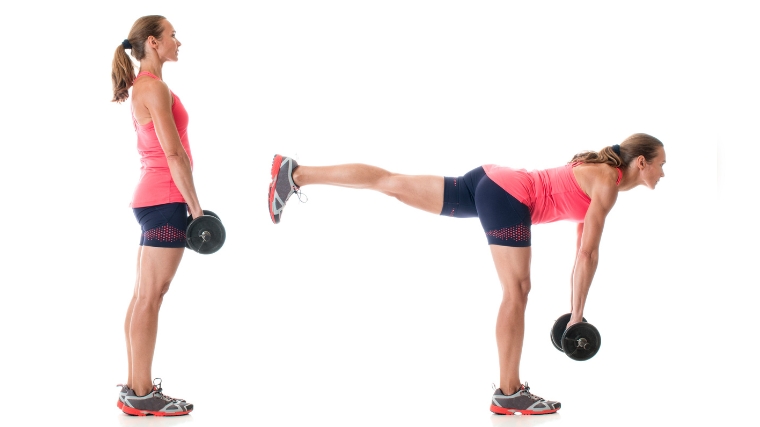
When you lift on one leg, your center of gravity must shift until it is directly above that leg; the barbell has to move over, too. So, when you do single-legged deadlifts, make sure that you hold the barbell directly in front of your working leg. Otherwise, things can feel lopsided or awkward.
Single-Leg Deadlift Variations
The single-leg deadlift is a variation in and of itself. That said, you can iterate on any movement to make it easier or harder depending on your needs.
Kettlebell Single-Leg Deadlift
Kettlebells are fantastically ergonomic — they feel natural to hold and work with as an external object. As such, if you’re struggling to balance the barbell during single-leg deadlifts, you can regress to a kettlebell instead.
Not only will switching to a kettlebell help concentrate the weight itself directly over your foot, but you only need to hold it with one arm. You can use your free arm as a counterbalance if you hold it aloft at your side.
B-Stance Deadlift
Unilateral training comes with a whole medley of different physiological benefits. You have a lot to gain by working on one leg or with one arm, however, those with particularly poor balance skills may feel left out in the cold.
If you can’t seem to keep things steady during a regular single-legged deadlift, you can shift to the “B-stance” instead. B-stance exercises require less balance and coordination, as they allow you to place your non-working leg gently on the ground for stability.
This enables you to place most of the load on one leg at a time without worrying about whether or not you’ll topple over between reps.
Single-Leg Deadlift Alternatives
The single-leg deadlift might be alluring on paper but impractical in the gym. For whatever reason, the exercise just doesn’t click with you. If that’s the case, you need an alternative exercise that offers similar benefits in a more accessible fashion. Try some of these alternatives.
Single-Leg Hip Thrust
Hip thrusts are all the rage for building your glutes, and for good reason — they work. Thrusting on one leg is just as potent and, more importantly, requires a lower degree of balance and stability to perform.
This exercise is also great if you experience some lower back pain or discomfort during the single-leg deadlift. Thrusting patterns apply much less tension to the lumbar spine by nature.
B-Stance Romanian Deadlift
The B-stance Romanian deadlift hits just about every beat of a single-legged deadlift, without requiring that you actually balance on one leg at a time to perform the movement. By placing your non-working leg into a kickstand position, you can focus on working one side of your body at a time.
This exercise also closely mimics the hinge patterning of a single-legged deadlift. You can use it as a full-on replacement, or as a precursor if you want to work up towards single-leg pulls in the future.
Single-Leg Back Extension
If you have access to a 45-degree back extension station at your local (or home) gym, you can closely mirror the single-leg deadlift without even having to utilize any weights at all.
Single-leg back extensions are a surprisingly-challenging alternative to working with free weights. All you have to do is lock yourself into the station and then remove your non-working leg from the calf pad before performing the movement. Your glute and hamstring on each side will have to work double time to lift and lower your torso.
Muscles Worked by the Single-Leg Deadlift
Standard barbell deadlifts may work just about every muscle in your body, but the more you deviate from the “original” exercise, the more specialized it becomes. This affects which muscles you work to a degree as well.
Glutes
Your glutes are among the most powerful and robust muscles in your body. Located on the back of your pelvis, they serve as, primarily, hip extensors during any kind of deadlift — they help you stand up.
Exercises like the single-leg deadlift are phenomenal glute builders because they apply mechanical tension to the muscle throughout its entire functional range. That’s why you’ll feel your glutes working both at the bottom of each rep and all the way up to the top.
Related: Best Glutes Exercises
Hamstrings
Your hamstrings are located on the back of your thigh. They serve many of the same functions as your glutes, but your hamstrings also cross your knee joint, making them biarticular. Meaning, if you want to work your hammies, either your hip or knee must bend while the other remains straight.
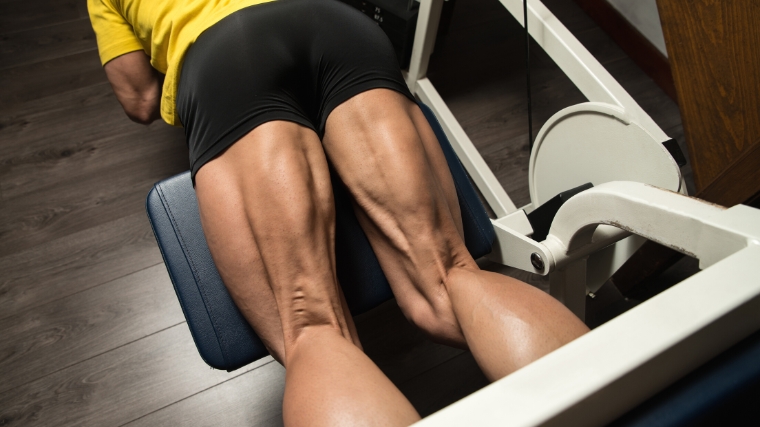
As such, hinge variations are the go-to for hamstring stimulation, since your knee remains locked or very slightly bent throughout the set. This keeps the tissue taut and tense and is a great stimulus for growth.
Lower Back
Just about every compound, lower-body exercise — including the single-leg deadlift — will tax your lower back to some degree. Your lumbar spine is encased in layers of protective tissue, including your powerful spinal erector muscles.
[Read More: Best Lower Back Exercises for Strength and Reduced Pain]
These muscles help pull your torso upright, but in the deadlift, they contract isometrically: They don’t flex and extend, but squeeze hard while remaining motionless. You need a strong lower back to create midline stability so your other muscles (think of your glutes and hamstrings again) can pull on your joints.
Core, Forearms, & Grip
They’re worth mentioning, even if they don’t steal the show — all deadlifts require you to physically hold the weight you’re using (if you’re using weight, that is). As a consequence, you’ll get a bit of “extra credit” stimulation to your forearms and grip.
Your core also has a crucial role to play; you have to contract your abdominals hard to maintain a 360-degree, comprehensive core brace. This allows you to effectively transfer force through your body, ensuring high-quality reps each and every time.
Benefits of the Single-Leg Deadlift
The single-leg deadlift serves many purposes; for powerlifters, it’s an awesome accessory movement. For those interested in adding some muscle, it works pretty well on leg day. If you have movement or balance issues, it can even be rehabilitative in the right contexts.
Helps You Address Imbalances
Single-limb training is a phenomenal way to identify and attack any side-to-side discrepancies in mobility or strength you may not otherwise notice. For example, if you’re able to hold yourself steady while working your right leg but can’t do the same on your left, that difference might be worth investigating.
An exercise like the single-leg deadlift can be a great tool to scan yourself for performance-related deficits without straying too far from the deadlift itself.
Provides a Lot of Stimulation With Light Weights
To grow muscle, you need a combination of mechanical tension, metabolic stress, and muscle damage, mostly in that order of importance. While you can only lift a fraction of your heaviest deadlift on the single-leg variation, that doesn’t mean it’s any worse for muscle growth.
In fact, it may even be better. Standing on one leg requires you to slowly lower the weight down and display eccentric control from top to bottom, while the regular deadlift doesn’t have a dedicated eccentric phase.
Eccentric training is fantastic for both strength and hypertrophy, and is an essential component of the muscle-growing process. (1)
Great for Training Balance
Above all, the single-leg deadlift demands a lot of your balance. While most gyms contain equipment that is supposedly meant to improve your balance and stability, research has demonstrated that working on an unstable surface like a Bosu ball isn’t productive in all cases. (2)
Planting one foot firmly on the floor and challenging that leg to work hard under load is a straightforward and effective way of improving your balance. The single-leg deadlift is a fantastic choice in this regard.
Who Should Do the Single-Leg Deadlift
No exercise is for everyone, but the single-leg deadlift can find a home in many different workout routines or training styles. Here are a few prime examples.
Powerlifters, as an Accessory Lift
Recreational or competitive powerlifters devote hours and hours every week to perfecting their squat, bench press, and deadlift. Each of those three movements also comes with a host of accessory exercises meant to supplement weaknesses.
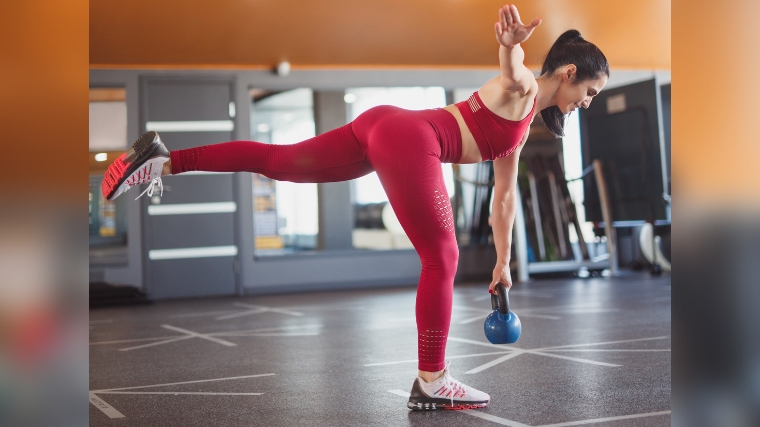
The single-leg deadlift serves a dual purpose for the strength athlete; it provides valuable unilateral work while also closely mirroring the motor pattern of the deadlift itself (provided you pull with a conventional stance).
Those Trying to Gain Muscle
Building muscle mass is all about finding the exercise that works best for you. The single-leg deadlift has a lot of good things going for it, but before you incorporate it into your next leg or back day, make sure the exercise aligns well with your body. If it feels good, go to town — your hamstrings and glutes will be on fire.
Anyone Who Needs to Train Their Balance
If you’re in the market for a balance-building movement that also builds muscle, the single-leg deadlift is a prime choice. It has a challenging, but manageable, difficulty curve. After a few weeks, you should notice a real difference in your single-leg stability.
The Balance of Power
No variation of the deadlift does everything — not even the deadlift itself. Pulling on floor-shatteringly heavy weights is rewarding, but sometimes you might need a more specialized touch to reach your fitness goals. Changing things up and making new gains can be as simple as standing on one leg at a time.
FAQs
Still stumbling over the single-leg deadlift? Here are a couple of common questions about the exercise that may help you.
Do I have to use weights with the single-leg deadlift?
Depending on your level of strength and coordination, not necessarily. For some gymgoers, even the empty bar alone is mighty stimulating. Over time and as your competence improves, you may want to start stacking plates onto your bar to continuously drive progress.
Are single-leg deadlifts bad for my back?
No movement is inherently dangerous. It’s all about how heavy you load it and whether or not the technique is sustainable. The single-leg deadlift will work your spinal erectors to a degree, but there should be a clear distinction between muscular fatigue and real pain. If you experience the latter, seek out a different movement.
References
- Douglas, J., Pearson, S., Ross, A., & McGuigan, M. (2017). Chronic Adaptations to Eccentric Training: A Systematic Review. Sports medicine (Auckland, N.Z.), 47(5), 917–941.
- Lehman G., Gilas D., Patel U. (2008) An unstable support surface does not increase scapulothoracic stabilizing muscle activity during push up and push up plus exercises. Manual Therapy 13(6), 500-506.
Featured Image: Max kegfire / Shutterstock